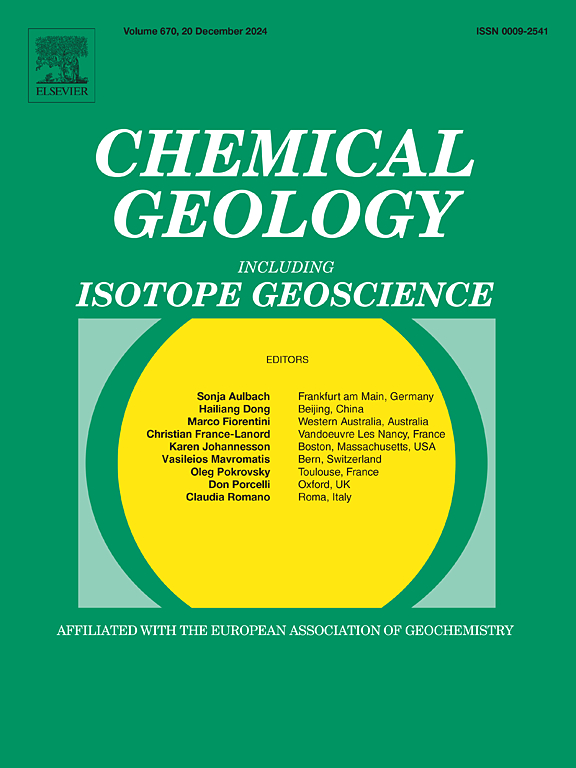Pressure sensor based on the Raman shift of the 128-cm−1 band of quartz for pressure measurements in hydrothermal diamond-anvil cells
IF 3.6
2区 地球科学
Q1 GEOCHEMISTRY & GEOPHYSICS
引用次数: 0
Abstract
To interpret data collected from high-pressure (P)–temperature (T) experiments simulating geological processes, pressure information during these experiments is crucial. Traditionally, the Raman shifts of the quartz 464-cm−1 band are commonly used as a hydrostatic-pressure calibrant in such experiments, particularly in those performed using hydrothermal diamond-anvil cells (HDACs). In this study, we conducted experiments using HDAC and a Raman spectrometer to investigate the sensitivity of the quartz 128-cm−1 Raman band to changes in P and T. We found that the Raman shift of this band exhibits higher sensitivity to changes in P and T than the 464-cm−1 band at Ts above 200 °C. Changes in the Raman shift of the 128-cm−1 band with Ps and Ts are 9–16 cm−1/GPa and ~ (50–40) × 10−3 cm−1/°C, respectively, at 200–700 °C and < 1.0 GPa; the corresponding values for the 464-cm−1 band are ~9 cm−1/GPa and ~14 × 10−3 cm−1/°C, respectively. The experimental data of Ps, Ts, and the Raman shifts of the quartz 128 cm−1 band relative to that at 0.1 MPa and 23 °C (∆ω128) were fitted into an equation to express their relation:
∆ω128 (cm−1) = 1.20176 × 10−10 × T4–1.64508 × 10−7 × T3 + 2.0665 × 10−5 × T2–0.02134 × T + 0.00599 × P + 1.60394 × 10−5 × T × P + 0.48515,
where 23 ≤ T (°C) ≤ 700, P (MPa) < 1000, and R2 = 0.9986. Based on the scattered experimental data, the error of this equation is ±20 MPa. Based on this equation, the hydrostatic P can be calculated at a specific T when ∆ω128 is obtained in high P–T experiments using HDAC or other types of optical cells.

基于石英128-cm−1波段拉曼位移的压力传感器用于热液金刚石-砧细胞的压力测量
为了解释从模拟地质过程的高压(P) -温度(T)实验中收集的数据,这些实验中的压力信息是至关重要的。传统上,石英464-cm - 1波段的拉曼位移通常用作此类实验中的静流体压力校准,特别是在使用热液金刚石砧细胞(hdac)进行的实验中。在这项研究中,我们利用HDAC和拉曼光谱仪进行了实验,研究了石英128-cm−1拉曼波段对P和T变化的灵敏度。我们发现,在200°C以上的温度下,该波段的拉曼位移对P和T变化的灵敏度高于464-cm−1波段。在200-700℃和<下,Ps和Ts对128-cm−1波段拉曼位移的影响分别为9-16 cm−1/GPa和~ (50-40)× 10−3 cm−1/°C;1.0绩点;在464 cm−1波段对应的值分别为~9 cm−1/GPa和~14 × 10−3 cm−1/℃。将石英128 cm−1波段的Ps、Ts和相对于0.1 MPa和23°C时(∆ω128)的拉曼位移的实验数据拟合成方程表示它们之间的关系:
本文章由计算机程序翻译,如有差异,请以英文原文为准。
求助全文
约1分钟内获得全文
求助全文
来源期刊

Chemical Geology
地学-地球化学与地球物理
CiteScore
7.20
自引率
10.30%
发文量
374
审稿时长
3.6 months
期刊介绍:
Chemical Geology is an international journal that publishes original research papers on isotopic and elemental geochemistry, geochronology and cosmochemistry.
The Journal focuses on chemical processes in igneous, metamorphic, and sedimentary petrology, low- and high-temperature aqueous solutions, biogeochemistry, the environment and cosmochemistry.
Papers that are field, experimentally, or computationally based are appropriate if they are of broad international interest. The Journal generally does not publish papers that are primarily of regional or local interest, or which are primarily focused on remediation and applied geochemistry.
The Journal also welcomes innovative papers dealing with significant analytical advances that are of wide interest in the community and extend significantly beyond the scope of what would be included in the methods section of a standard research paper.
 求助内容:
求助内容: 应助结果提醒方式:
应助结果提醒方式:


